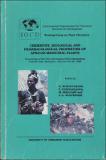| dc.contributor.author | Rodgers, C.B. | |
| dc.contributor.author | Verotta, L. | |
| dc.coverage.spatial | Africa. | en |
| dc.date.accessioned | 2016-04-25T15:08:54Z | |
| dc.date.available | 2016-04-25T15:08:54Z | |
| dc.date.issued | 1996-02-25 | |
| dc.identifier.citation | Rodgers, C.B. and Verotta, L. (1996) Chemistry and biological properties of the African Combretaceae. In: Hostettmann, K., Chinyanganya, F., Maillard, M. and Wolfender, J.-L. (eds.) Chemistry, biological and pharmacological properties of African medicinal plants: proceedings of the first International IOCD-Symposium, Victoria Falls, Zimbabwe, February 25-28 1996. Harare: UZ Publications, pp. 121-143. | en |
| dc.identifier.isbn | 0-908307-59-4 | |
| dc.identifier.uri | https://opendocs.ids.ac.uk/opendocs/handle/20.500.12413/11405 | |
| dc.description | A conference paper on medicinal plants species of Africa. | en |
| dc.description.abstract | Of the many genera that comprise the African Combretaceae, the two largest, Combretum and Terminalia, occur in most parts of Africa where they are often the dominant groups as regards numbers. They consist of climbers, shrubs and trees and are readily characterised by fruits with wing-shaped appendages.
Although traditional healers throughout Africa have used species of the Combretaceae for the treatment of a wide range of disorders, only about twenty five out of the approximately ninety nine African species of Combretum have been subjected to any form of scientific study; with the exception of a few species of the Terminalia, Anogeissus and Guiera. virtually nothing has been reported on the phytochemistry of any of the remaining genera. This family thus represents a practically unexplored reservoir of potentially useful substances.
Metabolites isolated so far include alkaloids (G. senagalensis). tannins (A. schimperi), flavonoids (C. micranthum), and amino acids (C. zeyheri): substituted phenanthrenes from various heartwoods; a rich variety of triterpenoid acids and their saponins mainly of the cycloartane (C. mode) and oleanc (C. imberbe) types; and a series of unique stilbenes, their glucosides. and macrocyclic lactones called combretastatins (C. caffrum, C. kraussii). Many of the Combretum species exude gums that are similar in composition and properties to gum arabic. | en |
| dc.description.sponsorship | International Organization for Chemical Sciences in Development (IOCSD) | en |
| dc.language.iso | en | en |
| dc.publisher | University of Zimbabwe (UZ) Publications | en |
| dc.rights.uri | http://creativecommons.org/licenses/by-nc-nd/3.0/ | en |
| dc.subject | Environment | en |
| dc.subject | Health | en |
| dc.subject | Science and Society | en |
| dc.title | Chemistry and biological properties of the African Combretaceae | en |
| dc.type | Conference paper | en |
| dc.rights.holder | University of Zimbabwe (UZ) | en |


